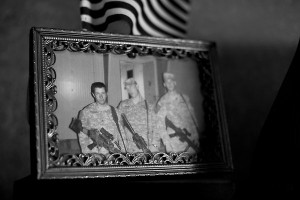Ogni 36 ore un soldato americano si suicida. Una vergogna, titola il New York Times che ha dato conto il 14 aprile di questo baratro sconosciuto.
Ne uccide più la depressione, che li spinge al suicidio, che non i nemici sul campo di battaglia. Le statistiche dei morti tra i militari americani in servizio mostrano per il 2010, ed è il secondo anno di fila, che il numero dei soldati che si sono tolti la vita è più alto di quelli caduti in guerra in Iraq e in Afghanistan, 468 contro 462. Dall’inizio della missione a Baghdad, nel 2003, il tasso dei suicidi nelle forze armate americane è continuato a salire, secondo un recente studio del Comando per la Salute dell’esercito Usa che ha rilevato un incremento dell’80% dei suicidi nel personale in divisa tra il 2004 e il 2008. In parallelo sono cresciuti anche i tassi di depressione, ansietà e altre malattie mentali. Per Kristof “un soldato americano muore ogni giorno e mezzo, in Irak o in Afghanistan, e i veterani si suicidano ad un tasso di uno ogni 80 minuti. Ci sono ogni anno circa 6500 veterani che si tolgono la vita, e sono più del numero totale di militari uccisi mentre erano in missione in Iraq o in Afghanistan fin dall’inizio delle due guerre”.
Op-Ed Columnist
A Veteran’s Death, the Nation’s Shame
By NICHOLAS D. KRISTOF
Published: April 14, 2012
HERE’S a window into a tragedy within the American military: For every soldier killed on the battlefield this year, about 25 veterans are dying by their own hands.
An American soldier dies every day and a half, on average, in Iraq or Afghanistan. Veterans kill themselves at a rate of one every 80 minutes. More than 6,500 veteran suicides are logged every year — more than the total number of soldiers killed in Afghanistan and Iraq combined since those wars began.
These unnoticed killing fields are places like New Middletown, Ohio, where Cheryl DeBow raised two sons, Michael and Ryan Yurchison, and saw them depart for Iraq. Michael, then 22, signed up soon after the 9/11 attacks.
“I can’t just sit back and do nothing,” he told his mom. Two years later, Ryan followed his beloved older brother to the Army.
When Michael was discharged, DeBow picked him up at the airport — and was staggered. “When he got off the plane and I picked him up, it was like he was an empty shell,” she told me. “His body was shaking.” Michael began drinking and abusing drugs, his mother says, and he terrified her by buying the same kind of gun he had carried in Iraq. “He said he slept with his gun over there, and he needed it here,” she recalls.
Then Ryan returned home in 2007, and he too began to show signs of severe strain. He couldn’t sleep, abused drugs and alcohol, and suffered extreme jitters.
“He was so anxious, he couldn’t stand to sit next to you and hear you breathe,” DeBow remembers. A talented filmmaker, Ryan turned the lens on himself to record heartbreaking video of his own sleeplessness, his own irrational behavior — even his own mock suicide.
One reason for veteran suicides (and crimes, which get far more attention) may be post-traumatic stress disorder, along with a related condition, traumatic brain injury. Ryan suffered a concussion in an explosion in Iraq, and Michael finally had traumatic brain injury diagnosed two months ago.
Estimates of post-traumatic stress disorder and traumatic brain injury vary widely, but a ballpark figure is that the problems afflict at least one in five veterans from Afghanistan and Iraq. One study found that by their third or fourth tours in Iraq or Afghanistan, more than one-quarter of soldiers had such mental health problems.
Preliminary figures suggest that being a veteran now roughly doubles one’s risk of suicide. For young men ages 17 to 24, being a veteran almost quadruples the risk of suicide, according to a study in The American Journal of Public Health.
Michael and Ryan, like so many other veterans, sought help from the Department of Veterans Affairs. Eric Shinseki, the secretary of veterans affairs, declined to speak to me, but the most common view among those I interviewed was that the V.A. has improved but still doesn’t do nearly enough about the suicide problem.
“It’s an epidemic that is not being addressed fully,” said Bob Filner, a Democratic congressman from San Diego and the senior Democrat on the House Veterans Affairs Committee. “We could be doing so much more.”
To its credit, the V.A. has established a suicide hotline and appointed suicide-prevention coordinators. It is also chipping away at a warrior culture in which mental health concerns are considered sissy. Still, veterans routinely slip through the cracks. Last year, the United States Court of Appeals in San Francisco excoriated the V.A. for “unchecked incompetence” in dealing with veterans’ mental health.
Patrick Bellon, head of Veterans for Common Sense, which filed the suit in that case, says the V.A. has genuinely improved but is still struggling. “There are going to be one million new veterans in the next five years,” he said. “They’re already having trouble coping with the population they have now, so I don’t know what they’re going to do.”
Last month, the V.A.’s own inspector general reported on a 26-year-old veteran who was found wandering naked through traffic in California. The police tried to get care for him, but a V.A. hospital reportedly said it couldn’t accept him until morning. The young man didn’t go in, and after a series of other missed opportunities to get treatment, he stepped in front of a train and killed himself.
Likewise, neither Michael nor Ryan received much help from V.A. hospitals. In early 2010, Ryan began to talk more about suicide, and DeBow rushed him to emergency rooms and pleaded with the V.A. for help. She says she was told that an inpatient treatment program had a six-month waiting list. (The V.A. says it has no record of a request for hospitalization for Ryan.)

